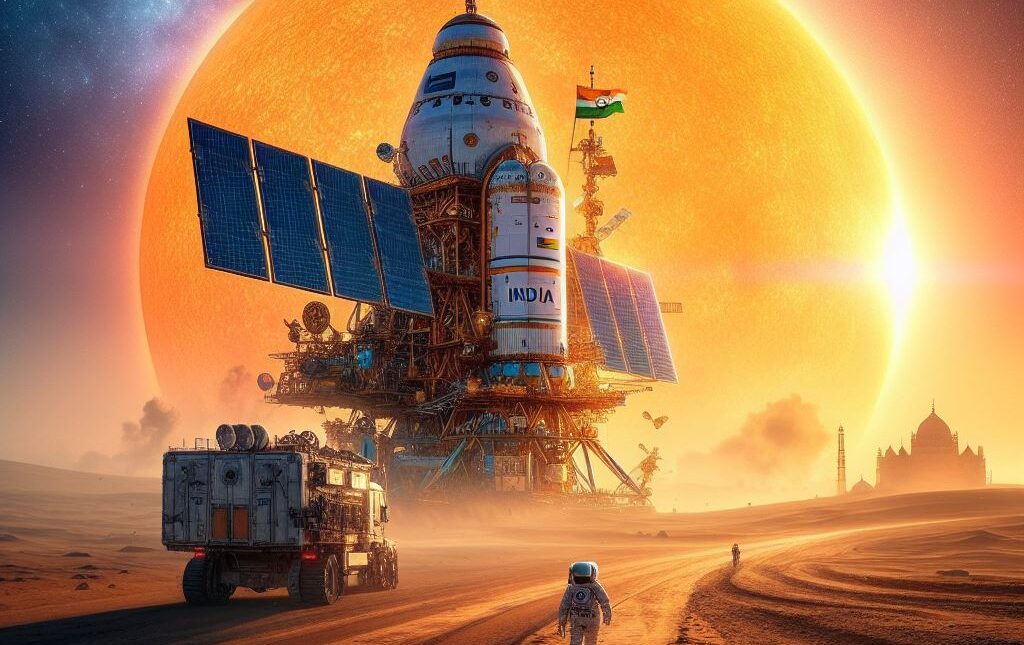India’s first mission to the Sun, India’s Aditya-L1 Mission Reaches Sun’s Orbit in the Lagrange point 1 (L1) – a spot where the gravitational forces of the Sun and the Earth cancel each other out, allowing a spacecraft to “hover”. The Indian Space Research Organisation (ISRO) announced the successful arrival of the satellite on Saturday, January 6, 2024, after a four-month journey from the Earth.
Aditya-L1 was launched on September 2, 2023, from the Satish Dhawan Space Centre in Sriharikota, Andhra Pradesh, on board a Polar Satellite Launch Vehicle (PSLV). It carried seven scientific instruments that will observe and study various aspects of the Sun, such as the solar corona, the photosphere, the chromosphere, the solar wind, and the magnetic field
India’s Eye on the Sun: Aditya-L1 Mission Successfully Reaches Its Orbit
Mumbai, India: On September 7th, 2023, India’s ambitious Aditya-L1 mission embarked on a journey to unlock the secrets of our closest star. After a four-month voyage, the spacecraft successfully entered its final halo orbit around the Sun-Earth Lagrange point 1 (L1) on December 8th, 2023. This historic achievement marks a significant milestone in India’s space exploration endeavors and opens a new chapter in our understanding of the Sun’s influence on Earth.
A Beacon of Knowledge:
Aditya-L1, named after the Hindu Sun God, carries a sophisticated payload of seven instruments designed to study the Sun’s corona, chromosphere, and photosphere. These instruments will gather crucial data on solar flares, coronal mass ejections, and the Sun’s magnetic field, shedding light on the complex processes that drive solar activity.
Why L1?
The L1 point is a gravitational sweet spot located approximately 1.5 million kilometers from Earth, where the combined forces of the Sun and Earth cancel each other out. This unique position allows Aditya-L1 to maintain a stable orbit while continuously observing the Sun without interference from Earth’s magnetic field or atmosphere.
Unveiling the Mysteries:
Understanding the Sun’s behavior is crucial for predicting space weather events that can disrupt satellites, power grids, and communication systems. Aditya-L1’s observations will help us develop accurate forecasting models and mitigate the potential harm caused by solar storms. Additionally, the mission aims to answer fundamental questions about the Sun’s corona, which is surprisingly hotter than its surface.
A Collaborative Triumph:
Aditya-L1 is a testament to India’s growing prowess in space technology. The successful launch and orbit insertion demonstrate the country’s commitment to scientific advancement and its ability to compete with global spacefaring nations.
The Future Beckons:
Aditya-L1 is expected to operate for at least five years, providing a continuous stream of data for scientists to analyze. The mission’s findings have the potential to revolutionize our understanding of the Sun-Earth connection. The mission also pave the way for future solar exploration endeavors. As India’s eye gazes upon the Sun, the world eagerly awaits the scientific breakthroughs that Aditya-L1 promises to deliver.
This mission is not just a scientific triumph for India, but it also holds immense potential to benefit humanity. By understanding the Sun better, we can better protect ourselves from its harmful effects. We can harness its vast energy potential for a brighter future.
Aim of India’s Aditya-L1 Mission Reaches Sun’s Orbit
The mission aims to provide insights into the origin and evolution of the Sun. This source of energy causes life on Earth, and influence on the climate and space weather. It will also help scientists understand the solar activity. Such as the solar flares, wind and storms, and their effect on Earth and near-space environment in real time.
ISRO chief Sreedhara Panicker Somanath said the mission was a “milestone” for India’s space programme. It was a “tribute” to the Aditya, after whom the satellite was named. He also thanked the scientists, engineers, and technicians who worked on the mission. He also thanked the public and the media for their support and interest.
Prime Minister Narendra Modi and Aditya-L1 Mission
Prime Minister Narendra Modi congratulated ISRO and the nation on the achievement. He said that Aditya-L1 was a “shining example” of India’s scientific excellence and innovation. He also said that the mission would “enhance our understanding of the Sun and its impact on our planet.”.
Aditya-L1 is expected to operate for at least five years in the L1 orbit. This orbit is about 1.5 million km (932,000 miles) from the Earth – 1% of the Earth-Sun distance. From this vantage position, it will be able to watch the Sun constantly and carry out uninterrupted observations.
Aditya-L1 is India’s second major space mission in 2023, after the historic landing of the Chandrayaan-3 rover near the Moon’s south pole in August. India has also planned to launch its first manned space mission, Gaganyaan, in 2024, as well as several other satellites and probes in the coming years.


